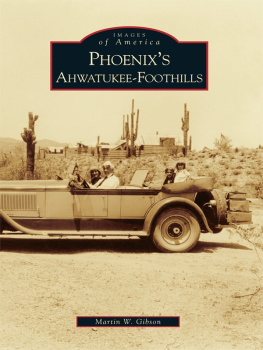Table of Contents
This book is about men who destroyed lives.
I would like to dedicate it to two men who save them.
To Ted and Hrayr,
the world needs more of you.
Men never know where wandering fiends wait in the dark.
BEOWULF
Well, a lot of it is I didnt want to lose my place to stay.
Uh, stupid.
SAM DIETEMAN
Prologue
No one wants to wake up to headlines that a serial killer is active in ones own community. How much more horrifying, then, to stare at the TV as authorities in angry voices declare there are not one, but two serial killers actively plucking victims off our streets and ending their lives. In 2006 in Phoenix, Arizona, thats exactly what happened. Even after having lived here more than twenty years, I had never heard of even one serial killer operating in this city. Like most other Phoenicians, I was incredulous. The words of the mayor and the police seemed incomprehensible, as if spoken in a foreign language. Our faces collectively scrunched up as if knit brows, narrowed eyes and dropped jaws could help us uncrack their code.
To those of us in the Valley of the Sun, a metroplex with a small downtown surrounded by hundreds of square miles of desert suburbs, a place where swimming pools are more common than public transit, and golf courses far outnumber factories, the words serial killer seemed like an import or, better yet, a fantasy. Serial killers could be found on movie screens or far away in the more crowded and established areas of the country, but surely not in sun-baked Phoenix, a place too busy still inventing itself to foster such curdling evil.
And yet, here were familiar and trusted faces, Phoenix Mayor Phil Gordon and Assistant Chief Kevin Robinson and Sergeant Andy Hill of the Phoenix Police, earnestly warning us to stay off the streets after dark. They insisted we had two separate killers in our midst. One, they said, wanted women. He raped them, often two togethersisters, coworkers, etc. Sometimes he killed them. He was operating along the southern edge of the metroplex, generally along a thoroughfare called Baseline Road, which is the final major dividing line between city life and raw desert. He would come to be known as the Baseline Rapist. The word rapist was used in his moniker, because the word killer was in high demand at the moment.
The other serial killer, they told us, was a much different person. He did not care to get as close to his victims as did the Baseline Rapist. This one remained unseen, blasting a shot in your back, then speeding off in a car. This one didnt care if you were a man or a woman, young or old, white or black, red or brown. He wanted everything in his pathif he didnt take your life, hed take your pets.
The occurrence of two separate serial killers operating independently in the same city at the same time is rare. This was a city that had not seen any serial killers at all in more than a generation, at least, and the law enforcement community, as fine and dedicated as it was, was not institutionally experienced in the phenomenon. The information over the months of 2006 came out in sputters and contradictions. At times, the authorities even talked about having three serial killers working. It was a nightmare bounded only by Baseline Road and sundown.
The Baseline Rapist abandoned some of his victims after as saulting them but not killing them. These survivors gave police a consistent description. Police developed a sketch of a man with a turned-down fishing hat, dreadlocks and a dark complexion.
By contrast, there were no sketches of the other killer. Most of his victims were unable to describe him because they had been shot in the back, had died, or were animals. Anyone who did catch a glimpse and also survived could only describe the vehicle, and this vehicle seemed variable.
Whether the victim died or managed to survive, lives were changed. Indeed, the entire community was changed. Phoeniciansat the water cooler, at the bus stop, at the sandwich shopstruck up conversations comparing notes and trying to understand.
Citizens developed strategies for safety. Habits were changed and plans altered. In this hot desert town, its not uncommon for people to work, play or exercise after sundown, when the brutal UV rays of daylight retreat. But in 2006 more and more people canceled their night activities. By summertime, the town was in a frenzy of fear, with hundreds showing up at community meetings held in school auditoriums. Police fielded questions from frightened and outraged citizens at these meetings and offered their best advice for safety. They distributed the sketch of the Baseline Rapist and advised women to avoid all strangers, as survivors reported that the Baseline Rapist had tended to engage them in innocent conversation before he attacked, asking directions or the time.
But for the other guy there was no sketch, and the advice amounted to keep yourself and your pets inside after dark. And the advice wasnt being directed just to womenit was for everyone. As prosecutor Laura Reckart would later say to a judge, Everyone in this room was a target.
The second killer left no psychological or geographical footprint to incorporate into a moniker. His attacks were random and scattershot. His name became simply the Serial Shooter. Not all of his attacks were made public. Indeed, as this story will demonstrate, police themselves often did not know which cases to lay at his feet. But the cases that found their way into public consciousness seemed to show the Serial Shooter working on the farthest western edge of the Phoenix metroplex, a side of town characterized by farmland and rodeo. Then he moved to downtown Phoenix, where our high-rises and our urban blight are. But in the spring he started moving farther and farther out of Central Phoenix, until the hideous day when young Robin Blasnek was killed in the stalwart pillar of the East Valley, Mesa.
The shooting of Robin Blasnek shocked the Phoenix area a magnitude of order higher than all the others. Robin was the victim we knew the most about. Her photo appeared everywhere, and the entire community grieved with and for her family. She became everyones daughter. After she was shot on a Sunday night, everyone in the Phoenix area followed her case daily hourlyand before long we all knew that her funeral would be Saturday. It would be a public one, in the way that sudden celebrity takes over such events.
With the shooting of Robin Blasnek, the last vestiges of security left this community. The killing had now swept from the rural Westside more than thirty miles to the yuppie East Valley. It had devastated Central Phoenix and touched down in the northern neighborhoods as well. The Baseline Rapist was also expanding his territory. Law enforcement resources, as every citizen could deduce for himself, were stretched to the breaking point. Publicity went nationwide. Squads of Guardian Angels arrived from out of state to help patrol.
This book is the story of what happened that year. Because the Baseline Rapist was easier to recognize as a single perpetrator soon after he began committing his crimes, his case had already usurped many of the resources of the Homicide units of the Phoenix Police Department. By the time investigators strung together, painfully, the other random cases of murder and mayhem that had languished on many different desks, the Homicide units were so overworked that an assault detective ended up being the lead investigator on the task force for the Serial Shooter. Thankfully, by the end of 2006, law enforcement had performed the amazing feat of taking into custody suspects for both cases.












